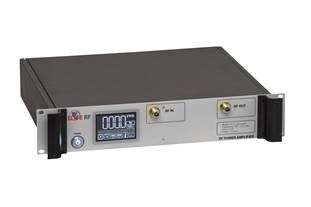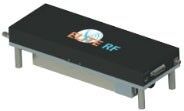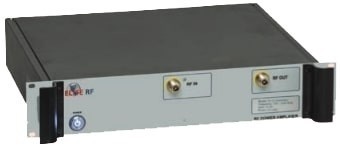Don't wanna be here? Send us removal request.
Text
Challenges in the Miniaturization of RF Amplifiers You need to know

In a world where consumer expectations are growing higher and higher, it's no secret that we all crave equipment that is smaller yet simultaneously more robust. Noticeably, this trend extends not just to the completed devices but also to their constituents, such as RF amplifiers.
RF amplifiers, or radio frequency amplifiers, are electronic devices designed to amplify radio frequency signals. These signals typically range from several kilohertz (kHz) to several gigahertz (GHz), encompassing the frequencies used in radio communication, television broadcasting, wireless networking, radar systems, and various other applications.
The primary purpose of an RF amplifier is to increase the power of an input RF signal without significantly distorting its waveform. So, as we're going towards miniaturization of RF amplifiers, some challenges require proper attention. In this blog, we'll discuss the challenges in the miniaturization of RF amplifiers.
What Are The Challenges In the Miniaturization of RF Amplifiers?
Component Integration
Once upon a time, miniaturizing an RF amplifier was the equivalent of trying to squeeze an elephant into a small car. It's about more than just the size; like trying to fit that elephant into a vehicle, integrating all components while retaining their functionality is no walk in the park.
The glitter of miniaturization is washed away by the reality: the challenge of ensuring efficiency. Miniaturization demands seamless integration of components within confined spaces. Achieving this integration without compromising performance is a delicate balance. The proximity of features can lead to unwanted coupling and interference, affecting the overall functionality of the RF amplifier.
Material Limitations:
You might be thinking, "Why can't we just build components from heat-absorbing materials?" If only it were that simple. Material selection is a delicate balance of compromise and availability
in RF Amplifier miniaturization.
It would help if you considered conductivity, durability, weight, and, most importantly, cost. Finding a material that ticks all these boxes can be tricky. If we add in the need for heat absorption, it's like attracting a unicorn, which exists but is extremely rare.
The choice of materials becomes critical when dealing with miniaturization. As components shrink in size, the properties of materials, including dielectric constants and conductive losses, can have a substantial impact on the performance.
Selecting materials that meet size constraints while maintaining signal integrity is a complex challenge.
Parasitic Effects
Miniaturization magnifies the influence of parasitic elements like capacitance, inductance, and resistance. These parasitic effects can disrupt the intended behaviour of the amplifier, leading to performance degradation. Mitigating these effects requires sophisticated design techniques and innovative approaches.
As size shrinks, pesky parasitic effects emerge. Capacitance, inductance, and resistance shoot through the roof, bringing all kinds of unexpected signal changes in the Miniaturization of RF Amplifiers. The struggle to minimize these effects while wallowing in space constraints is akin to playing whack-a-mole on a molecular level.
Signal Integrity
The downward size march doesn't make it easier to maintain signal integrity. Picture yourself trying to communicate in a crowded, narrow corridor.
The loudest voices (read most powerful signals) drown out the others, while some get lost in echo cacophony. Similarly, as the space for transmissions decreases, signals risk getting corrupted, drowned, or entirely lost. Doesn't sound too appealing.
Maintaining signal integrity is crucial for RF amplifiers, especially in applications where the quality of the signal is paramount. As components are miniaturized, signal losses, reflections, and distortions become more pronounced, demanding meticulous attention to detail in the design process.
Reliability Concerns
Shrinking the size of RF amplifiers raises concerns about their reliability, as smaller components may be more susceptible to environmental factors, heat, and mechanical stress. RF amplifier manufacturers must ensure the longevity and robustness of miniaturized RF amplifiers, which become critical considerations in their design and manufacturing.
Power Supply Concerns
Miniaturization often leads to power supply challenges as the available space for energy storage and regulation diminishes. Balancing power requirements with size constraints becomes a delicate task, requiring innovative solutions for efficient power delivery.
Power supply stability is another challenge in the miniaturization of RF amplifiers lurking in the shadows. Energy requirements must be met without compromising performance. Think of it as a high-wire balancing act, where you can't afford to sway too far in either direction. Too little power and the device performs under par; too much power and we're back to the heat and reliability issues.
Design Complexity
Miniaturization introduces an added layer of complexity in the design process. Engineers must navigate intricate trade-offs between size, performance, and other parameters, making the design process more challenging than traditional amplifier designs.
The intricate, visually appealing spider web of a circuit that's a joy to view is complex to design when physical space hits the scarcity crunch.
Bandwidth Limitations
Achieving broad bandwidth in RF amplifiers is inherently challenging in RF amplifiers miniaturization. The reduced physical size may limit the achievable frequency range, impacting the amplifier's versatility and adaptability to different communication standards.
Component Availability
The availability of miniature components meeting stringent performance criteria can be a bottleneck in the miniaturization process. Sourcing and utilizing high-quality, miniaturized components can pose challenges, influencing the overall feasibility of the design.
When you thought we were done with the hurdles, component availability crashes in uninvited. The finest components might only sometimes come in the exact pocket-sized package you need. It's like going shopping for plus sizes at a boutique that caters exclusively to supermodels. Sure, they have what you want, but probably not in the size you need.
Packaging and Shielding
Effectively packaging and shielding miniaturized RF amplifiers are crucial for preventing interference and maintaining signal integrity. The design of compact, efficient enclosures that protect against external electromagnetic influences adds another layer of complexity to the miniaturization endeavour.
Finally, after braving all these challenges, the miniaturized RF amplifier must be packed efficiently and shielded effectively.
Conclusion
In the relentless pursuit of smaller, more powerful electronic devices, the challenges in miniaturizing RF amplifiers are both numerous and formidable.
Engineers must navigate through a maze of design intricacies, material limitations, and reliability concerns to deliver compact yet high-performing amplifiers. Addressing these challenges requires a multidisciplinary approach, incorporating advances in materials science, circuit design, and manufacturing techniques.
As technology continues to advance,RF amplifier manufacturers must overcome these hurdles. After that, it will pave the way for a new era of compact and efficient RF amplifiers, contributing to the evolution of wireless communication systems.
0 notes
Text
The RF Amplifier Selection Guide
Whenever the matter revolves around wireless communication, there are different RF protocols to follow. Thanks to RF Amplifier Selection Guide, you will get the golden chance to learn about these points now. Most of the IC firms have taken a plunge towards betterment and produced transceiver ICs for covering some of the common protocols.
Based on the item you are making plans to develop, you will have to go for compact SoC, module or any transceiver IC for matching your different flexible needs. Only some of the most promising protocols will get to focus on the integration level. However, not all the items are subject to get beneficial results from integrated module or transceiver.
Time for the wireless communication:
While dealing with RF power amplifier specifications, you have to make sure to focus if you are aiming towards wireless communication or not.
For such wireless version, the RF amplifier is likely to form a major part of the RF front end and the signal chain within your product.
In case you are starting out your career panel as RF engineer and you are likely to select the best amplifier to the rescue, focus on the Types of amplifiers and the selection guidelines first.
Dealing with the important specifications is vital and you might have to pay some attention.
The type of amplifier you will choose will help in affecting the system, and the options that you can expect to find across in the market.
Focusing on the gain parameters:
Once you are sure of the answer on what is amplifier, you must learn about the types. In layman’s term, RF amplifiers are available in different forms and types, which are designed to address multiple application sections.
But, the broader diversity of the RF amplifier designs will not make it easier for you to select the preferred device for target application.
Even though the characteristics of every RF amplifier are available within its gain, it is not the only most important parameter to consider while making a choice.
The use of RF amplifier in front end and back end:
There are different components, which will appear towards the RF front end and the best ever RF Amplifier Selection Guide will help you in assisting the right choice.
The components in front end will mainly refer to all the circuitry, which will appear between the receiver or the transmitter antenna and also the digitalized processor.
The front end within a wireless product will appear as a major set of the discrete components, along with highly integrated module or SoC, Sets of ICs and anything that falls in between.
The RF amplifiers are mostly available in the Rx and the Tx parts of the RF system.
In case you are looking for a higher power transmitter, the power RF amplifier is widely used in Tx section. Then you have the Rx side using RF LNA to be added within the receiver.
With so many electronic components available in the market these days, you can endless options to give out a try.
Most of the transceiver ICs will have a flow to follow. On the Rx portion, the RF LNA must bring in the signal level up to a major level for demodulation and will run well below the saturation level.
On the other hand, you have the RF high power amplifier on the Tx portion, which will run closer to the saturation point to try and then maximize the present power output in desired frequency range. RF mixers are always noted to be a common part in this said conversion and modulator stage in RF front end.
At the end of this portion, you have the antenna switch. It is designed to swap between the Tx and Rx legs of the signal chain. In some of the systems like MIMO, there are multiple antenna switches used. These are perfect for sending in signals to various amplifier stages within Rx lines. On the other hand, you will see some modulations, which will take place upstream from all the switching spots.

The specifications to follow:
There are some major RF amplifier specifications that you need to be worrying about. All these points will finally impact the quality of the demodulated or received signals. Some of those specifications to keep a close watch on are:
3IP point and 1 dB compression points:
You are likely to have the 3rd-order intercept point, added to the frequency modulated signal and will be related to 1 dB compression point. The specification remains vital in the point amplifiers on the Tx sides as they are normally operated near the saturation point.
Gain and bandwidth:
These are some of the major specifications you have to consider while focusing on RF amplifier. These are mainly advertised when it comes to gain at specified frequency or the bandwidth. These terms are mostly summarized as gain-bandwidth product with cutoff frequency.
Some of the other specifications to follow on RF amplifier are going to be Gain flatness and Noise figure to name a few. With the help of RF amplifier manufacturer, you will receive all the valid information, mentioned in details, along with charts and diagrams to follow.
The final say:
It is indeed mandatory for you to check in with the best team of amplifier manufacturer as you are about to spend quite some money on it. For that, the source from Elite RF is more than happy to help!
#radio frequency power amplifier#radio frequency amplifier#rf power amplifiers#rf amplifiers#rf amplifiers manufacturers#high power amplifier#high power rf amplifier
0 notes
Photo

Product Name: Class A Ultra Linear Rack Mount W/Display
Model-DB.502.5G5048AC
Elite RF DA Series is a Class A, high-power 19” rack mount RF power amplifier providing ultra linear power over the specified bandwidth, ideal for a variety of high-power test setups as well as applications including communications, radar, electronic warfare, industrial, scientific, medical, and more. The internal amplifier utilizes LDMOS or GaN technology to achieve excellent gain.
For more details: https://eliterfllc.com/product/class-a-ultra-linear-rack-mount-w-display
0 notes
Photo

Product Name:500 Watt High Power Amplifier
Model- XX7.99.6G5760-XX
Elite RF H Series is a Class AB very high-power RF power amplifier rack system, which may be air-cooled or water-cooled. This amplifier provides linear power over the specified bandwidth, ideal for a variety of high-power applications up to 100 KW. The internal amplifier utilizes LDMOS or GaN technology to achieve excellent gain.
For more details: https://eliterfllc.com/product/500-watt-high-power-amplifier-systems
0 notes
Photo

Product Name:Class A Ultra Linear Rack Mount
Model- AA.026.0G4038AC
Elite RF AA Series is a Class A, high-power 19” rack mount RF power amplifier providing ultra linear power over the specified bandwidth, ideal for a variety of high-power test setups as well as applications including communications, radar, electronic warfare, industrial, scientific, medical, and more.
For more details: https://eliterfllc.com/product/class-a-ultra-linear-rack-mount-w-display
1 note
·
View note
Photo

Model: ML.01014G112415 .Elite RF ML Series is a low-noise rf amplifier product line offering industry-leading performance over various bands from 1 MHz to 18 GHz.
0 notes
Photo

Product : Class A ultra linear Module Model : MA.026.0G403850. Class A.
Elite RF MA Series is a Class A, high-power rf amplifier providing ultra linear power over the specified bandwidth, ideal for a variety of high-power test setups as well as applications including communications, radar, EW, industrial, scientific, medical, and more.
For more details visit - https://eliterfllc.com/
1 note
·
View note


